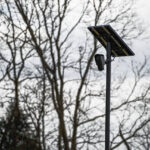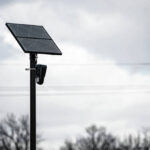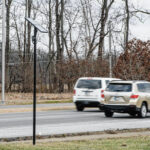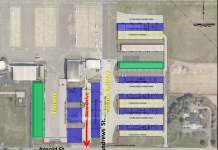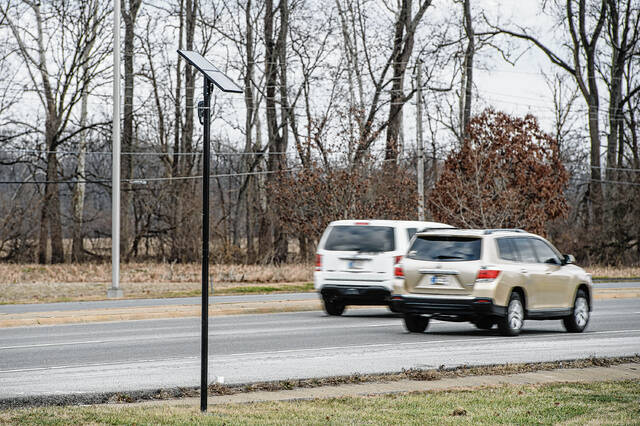
A license plate reading camera has been installed near on Jonathan Moore Pike near Morgan Willow Trace in Columbus.
Mike Wolanin | The Republic
The Columbus Police Department has started testing eight cameras that use artificial intelligence to read and record license plate numbers and other features of vehicles traveling through the city, more than doubling the number of cameras in the county that use the technology.
The cameras, made by Atlanta-based Flock Safety, capture still images of every vehicle that comes into view. The images are uploaded to a cloud server, and police are alerted when a vehicle that has been flagged for suspected involvement in a crime drives past. The cameras also are configured to alert police to vehicles that have been reported stolen or are associated with a missing person.
The information collected includes the license plate numbers and state, the vehicle color, make and model, “unique details” such as roof racks and bumper stickers, as well as the date and time of the image and how many times the vehicle has passed by the cameras over the past month, according to Flock Safety.
The cameras do not capture images of the vehicle’s occupants and are not used for traffic enforcement. All data and photos are permanently deleted after 30 days.
The camera system is part of growing industry of networked AI-powered technology capable of tracking vehicles as they move across the country. CPD’s cameras are connected to cameras used by other law enforcement agencies across the country and state, including police in Indianapolis, Franklin, Zionsville, Beech Grove, the Hancock County Sheriff’s Office — and the Bartholomew County Sheriff’s Department, which has been using four Flock Safety cameras for several months.
Flock Safety claims that its cameras operate in more than 1,500 cities and specifically advertises them to law enforcement, enticing them to “cover your city with cameras that see like a detective,” according to the company’s website.
CPD spokesman Lt. Matt Harris said the cameras went live on Jan. 7 as part of a free trial that ends March 8 and are located at various points throughout Columbus — including some that have been positioned to track vehicles entering or exiting the city. However, the cameras can be moved to other locations at any time “dependent upon the needs of a particular investigation.”
After the free trial period, CPD will evaluate their effectiveness and decide whether to continue using them. If CPD decides to proceed, the department plans to use no more than four cameras, Harris said. Each camera costs $2,500, plus a $250 fee, per year, according to a copy of an agreement between CPD and Flock Safety.
So far, the cameras have helped CPD make two arrests – including one suspect with an outstanding warrant and another arrest related to a stolen vehicle, Harris said.
“The technology with law enforcement is constantly changing and evolving, and this is just another tool that assists the officers,” Harris told The Republic.
“It’s like having an officer at a particular location just checking plates as they go by,” added later in the interview.
How the system works
The system uses a set of cameras that are programmed to take multiple still images of every vehicle that passes by, according the Flock Safety’s website. The company claims that the cameras can capture clear images of vehicles traveling up to 100 miles per hour — during the day and at night — at a distance of up to 75 feet.
The images are automatically uploaded to an encrypted “cloud” server operated by Amazon Web Services within seconds after the pictures are taken. Once in the “cloud,” the images are analyzed by machine learning algorithms that read and store the license plates and categorize other features of the vehicles.
The images and other data collected are then automatically uploaded to Flock Safety’s online portal, where Columbus police and Bartholomew County Sheriff’s deputies can log in to perform searches and create their own “hotlist” of vehicles that will trigger an alert sent to law enforcement officials if the wanted vehicle passes by one of the cameras. Users are also prompted to provide a reason for the search before submitting a search.
A recent demonstration of Flock Safety’s user interface by IPVM, a video surveillance industry news organization that often conducts product tests, showed that users can perform a wide range of searches, including by full or partial license plate numbers, make, model and color, among other criteria.
Locally, the system will draw upon vehicle information entered by police into the Indiana Data and Communications System, or IDACS, which is the statewide system used by law enforcement agencies that integrates information from national crime databases. Law enforcement agencies already use that database to run plates manually.
If the system spots a vehicle that has been flagged, it will send a notification to officers that they can access via a computer in each squad car.
Every CPD officer has a login for Flock Safety’s online portal and can perform searches, Harris said.
Privacy concerns
However, the camera systems have sparked controversy in other communities.
Privacy rights groups, including the American Civil Liberties Union and Electronic Frontier Foundation, have characterized the technology as a form of mass surveillance and have expressed concern that the cameras track vehicles — whether they have been flagged by police or not — and the technology has the potential to be abused.
The system also can connect cameras in multiple cities, meaning, for example, that Indianapolis police, which also has Flock Safety cameras, could perform a vehicle search that pulls in results that include images captured with cameras installed in Bartholomew County, and vice versa.
“If there’s one thing that we’ve learned from the growing use of automated license plate readers across the country is that these things are not incredibly targeted,” Matthew Guariglia, a policy analyst at the Electronic Frontier Foundation, told The Republic last year. “… For the most part, those cameras are on and they are recording every license plate that goes by, and so this includes the innocent and the guilty alike. And, of course, 99.9% of those people are innocent.”
“What automated license plate readers represent is the tracing of their movement as they go about their day,” Guariglia added.
However, the companies that make the systems, including Flock Safety, have said they take privacy “very seriously” and that privacy “is at the core of our design and factored into every product decision.”
Additionally, Flock Safety says that its customers own all of the images they capture through its system and that no vehicle data is sold to third parties.
“We are in the business of solving crime, not monitoring or tracking driving patterns,” the company states on its website. “Our customers know that the footage is to be used for an active investigation in solving a crime.”
‘They are working’
For their part, law enforcement across the country say the technology has been helpful at generating investigative leads and solving crimes that may have otherwise gone unsolved, pointing to what they describe as success stories. Some have claimed the cameras deter crime.
For example, Wichita police attributed the recovery of 68 stolen cars, 39 stolen license plates, 39 felony arrests, as well as the seizure of 13 guns, methamphetamine and other drugs in a little over a month, to automatic license plate readers, The Wichita Eagle reported.
Locally, the Bartholomew County Sheriff’s Office says it had received 17 “hits” on its cameras as of Wednesday, said Capt. Chris Roberts, commander of the Detectives Bureau of the Bartholomew County Sheriff’s Department, which oversaw the acquisition of the department’s cameras. A “hit” means that the cameras detected a license plate that matches a vehicle flagged in a crime database.
Those “hits” have led to six traffic stops and five arrests — including one individual who had out-of-county warrants for dealing methamphetamine, leaving the scene of an accident and resisting law enforcement — and the recovery of stolen vehicles, Roberts said.
“They are working,” Roberts said. “… I’m very pleased with it.”
Other concerns have involved the accuracy of these systems. In a recent product test, IPVM found that Flock Safety’s cameras were very accurate at reading license plate numbers, but at times, did misclassify the license plate state, vehicle type and make, including one instance where a yellow Nissan Xterra was identified as a bus.
The system also depends on crime databases containing accurate and updated information.
In one instance, the Flock Safety cameras notified Bartholomew County Sheriff’s deputies that a vehicle that had been flagged as stolen had just passed by one of its cameras.
Deputies were dispatched and verified that the vehicle was listed as stolen, Roberts said. When they performed a traffic stop, they discovered that the vehicle wasn’t stolen and the registered owner was behind the wheel.
“The reporting agency failed to remove the vehicle from actively being stolen,” Roberts said. “It was recovered, and it wasn’t removed from the computer system. … The owner was driving the vehicle, and the reporting agency just failed to remove it from the database.”
Local law enforcement officials say adequate safeguards are in place to ensure that the cameras will only be used for law enforcement purposes, including regular audits of searches that officers have done.
All searches are logged and recorded, Harris said.
“There are obviously rules that we have in place, policies and procedures in regard to that,” Harris said.
Columbus police and Bartholomew County Sheriff’s deputies don’t take the alerts at face value and conduct an investigation to verify the information sent by the camera sent before taking action, the two law enforcement agencies said.
“Just because Flock says it’s stolen, we don’t go on that information,” Roberts said. “We have to look at that information and verify it ourselves.”
Mike Wolanin | The Republic
A license plate reading camera has been installed near on Jonathan Moore Pike near Morgan Willow Trace in Columbus.
Mike Wolanin | The Republic
A license plate reading camera has been installed near on Jonathan Moore Pike near Morgan Willow Trace in Columbus.
Mike Wolanin | The Republic

